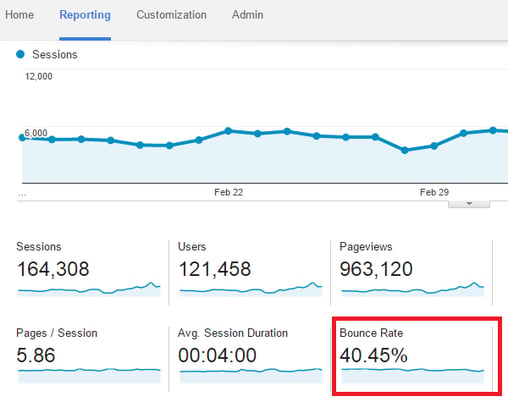What Is Google Analytics Bounce Rate & How To Reduce It
 Your Bounce Rate is a good indication of how successful or unsuccessful your webpages are at capturing a visitor’s interest. By analysing the bounce rate of different pages you can determine what approaches work and which do not, and how to improve your content to meet the requirements of your target market.
Your Bounce Rate is a good indication of how successful or unsuccessful your webpages are at capturing a visitor’s interest. By analysing the bounce rate of different pages you can determine what approaches work and which do not, and how to improve your content to meet the requirements of your target market.
In this article we will address two things: what bounce rate is and what steps you can take to reduce it.
What Is Bounce Rate?
In digital marketing, your bounce rate is the proportion of website visitors who arrive at your site through a particular page, and then “bounce out” - i.e. leave – without viewing any other pages. It is always given as a percentage figure.
There are some misconceptions about bounce rate that we would like to quickly clear up.
- Firstly, it shouldn’t be confused with how the term bounce rate is used in email marketing; where it denotes failed email deliveries.
- Secondly, bounce rate has nothing to do with the time a visitor spends on any given page. Whether they spend 30 seconds or five minutes on a page, if they fail to visit another page on your website, they are considered to have bounced.
- Thirdly, bounce rate is different to Exit Rate. Exit rate is the proportion of visitors who visit a webpage as the final destination within your website, before leaving. These visitors are not bouncers, as they may have visited several other pages before leaving.
One of the main reasons for using Google Analytics is to optimise your bounce rate. A low bounce rate suggests positive content that encourages visitors to explore other parts of the website. This increases the chance of lead generation. A high bounce rate, on the other hand, means people quickly lose interest. This could suggest your content is not appealing, or you are targeting the wrong people with your AdWords campaigns.
What Is A Good Bounce Rate?
Average bounce rates differ from industry to industry and from website to website. For instance, it is common for a blog to have a 70% plus bounce rate, although this would be a very disappointing figure for one of your core pages. As a general figure, we consider a bounce rate of 25% to 40% to be very good, with 40% to 60% being the average. If your bounce rate creeps above 55% it should ring alarm bells and prompt some action.
How To Improve Your Bounce Rate
So if your bounce rate is disappointing, what can you do about it?
1) Don’t Panic
Bounce rate is not the ultimate metric. You could still be getting conversions on bounced pages, so figure out what your individual bounce rate really means by comparing it with the time visitors spend on each page. For example, a bouncer who visits a landing page or blog but spend 10 minutes there is a hotter prospect than another bouncer who disappears after five seconds.
2) Focus On Your Most Profitable Pages
Don’t immediately try and reduce your bounce rate across the board. Use Google Analytics to create a profit index that indicates the pages most viewed immediately prior to conversions. These are the pages you should focus on first, as reducing the bounce rate here will improve your conversion rate.
3) Stop Targeting Low Value Traffic
A high bounce rate can indicate that the wrong people are visiting your site. Revisit your AdWords campaign and look at the keywords you are using. Are they bringing in visitors who are genuinely relevant to your business? Use negative keywords to exclude low value traffic.
4) Provide The Right Information
Another reason for bouncing is that visitors do not find the information they’re looking for. Rather than cramming your core pages full of too much information (this can increase bounce rate), set up one or more landing pages that address specific search queries.
5) Create A Call To Action
Visitors generally don’t take action unless they are prompted to do so. Fill your landing pages with a sense of urgency and a clear call to action (CTA) to direct a visitor’s journey around your website and encourage conversions.
Using Google Analytics to understand your website’s bounce rate is an important part of targeting your content to the right audience. For more information about setting up a bespoke marketing strategy, please get in touch with one of our digital marketing specialists today.


